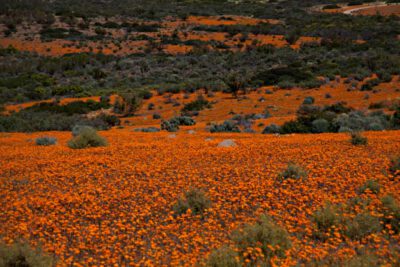
(CC BY 3.0)
Conservationists gathered in Namaqualand recently to celebrate a decade of successful expansion of protected areas within the Succulent Karoo biome of the Northern Cape.The celebration marked the closing out of the Northern Cape Land Project led by the Wilderness Foundation Africa (WFA) with funding from WWF South Africa through the Leslie Hill Succulent Karoo Trust, (LHSKT).
Key partners included landowners, SANParks, the Northern Cape’s Department of Agriculture, Environmental Affairs, Rural Development and Land Reform (DAERL) and Conservation South Africa.
Appropriately, the celebration was held in the town of Kamieskroon, a gateway to the Namaqua National Park which is world renowned for its annual spring flower display.
Over the past 10 years, the Northern Cape Land Project has enabled the declaration of five new nature reserves and one new protected environment with several more in the pipeline.
This conservation work has been done primarily through stewardship agreements with landowners who retain ownership of their land but commit to managing it in conservation compatible ways while continuing to derive economic benefit from it.
Katherine Forsythe, WWF project manager with the LHSKT, said a key benefit of the project has been the support WFA has provided to DAERL and SANParks in fine-tuning and streamlining processes and mechanisms for protected area expansion The work WFA has done in the Northern Cape has helped unlock doors and paved the way for biodiversity stewardship nationally. Also significant are the lasting relationships of trust that have been built between all parties in critical biodiversity areas.
Francois van der Merwe, chair of the LHSKT, noted that the threats to the Succulent Karoo were both “real and considerable”. In particular, he highlighted climate change which could see rainfall in the region decrease by some 40%, along with plant poaching and mining. This made the efforts to secure ecological corridors increasingly urgent.
Ben-Jon Dreyer, project manager with WFA, said: „Working on this project has been an eye-opener. There are so many landowners in the Succulent Karoo who realise the biodiversity significance of the land that has been entrusted to them and who strive to be the best possible stewards of it. It truly was a privilege to visit these stunningly beautiful and biodiverse landscapes, which will forever be etched in my memory.“
Matthew Norval, WFA’s Chief Operations Officer: Conservation, said that without the funding from Leslie Hill and the leadership of WWF South Africa, the opportunity to conserve these areas would have been lost.
“We came here with an understanding that there was a big conservation opportunity with lots of relatively intact vegetation and ecosystems that one could get back to functioning patterns and processes,” he said.
Norval said the work was a visible demonstration that land can remain in private hands and still be actively farmed while also contributing towards conservation targets, proving there need not be a trade-off between farming and conservation.
“I think there really has been a change in conservation which encompasses the appreciation of the natural environment, heritage and a realisation that we are doing this for our children and our children’s children,” he said.
One issue that has hampered statutory protection of these areas, however, has been the slow processing of proposed protected area submissions with some 22 243 hectares awaiting declaration including one more nature reserve and four new protected environments.
A further eight sites are also under negotiation. Once completed this would contribute a total of 70 000 hectares to conservation.
This work not only adds to South Africa’s protected area strategy but contributes towards the country’s international commitment to the Global Biodiversity Framework in Montreal in December 2022. Known as 30×30, this is a promise made by the international community to conserve 30% of terrestrial and marine environments by 2030.
Project highlights
- The declaration of five new provincial nature reserves, including four reserves created to protect the Northern Cape’s unique ‘mountain islands’ or inselbergs as part of the Karrasberge Protected Area. Another reserve is awaiting declaration and three more are under negotiation.
- The expansion of the Namaqua National Park, which now stands at 170 000 hectares.
- The creation of an ecological corridor linking the Tankwa National Park with the Cederberg as part of a long-held dream that started in 2008 to connect these two great wilderness areas.
- The declaration of the Gys Wiese Protected Environment (PE) adjacent to the Namaqua National Park. Four other PEs are awaiting declaration, including Sneeukop Protected Environment (PE) outside Kamieskroon which extends conservation across the N7 from the Namaqua National Park into the Kamiesberg.
Thanks to Leslie Hill
All those present at the celebration agreed that Mr Leslie Hill would have been proud of what had been achieved to date. It was his love of succulents and a generous endowment that led to the formation of the LHSKT that has enabled this work.
WFA will now be moving on to other projects in the Northern Cape, including expansion of the Augrabies National Park while the LHSKT will continue to fund work to consolidate what has been achieved in the area including exploring social benefits for local communities and supporting landowners in their stewardship efforts.
WWF South Africa
www.wwf.org.za






